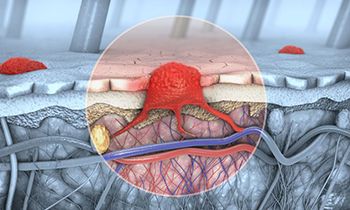Skin cancer is deadly disease, and melanoma is the most severe form of skin cancer. Since your skin is the largest organ of your body, you need to protect it to guard against skin cancer. Melanoma develops in stages. If you catch it early enough, your dermatologist at Century Medical and Dental Center can treat it relatively easily. But if you wait, melanoma is much more difficult to cure and requires more invasive procedures. So if you suspect you have early symptoms of melanoma, call for an appointment today!

The color of your skin is predetermined by the cells — called the melanocytes — that produce melanin. Found at the bottom layer of your skin, the melanocyte cells cover your body, since skin is the largest organ in humans. Melanoma is the type of cancer that develops in these cells. It’s the most dangerous kind of skin cancer.
Like many cancers, the exact cause of melanoma isn’t definitively known. Your best Brooklyn dermatologist at Century Medical and Dental Center suspects some contributing factors, such as the ultraviolet radiation from the sun and tanning beds. Limiting your exposure to the sun and avoiding tanning beds helps reduce your risk of developing melanoma.
Although melanoma can develop anywhere on your body, it often shows on your legs, arms, back, or face, as these areas are more often exposed to the sun. You should monitor areas that don’t normally see sunlight as well. You can even develop melanoma on the soles of your feet, the beds of your fingernails or the palms of your hands, especially if you have naturally darker skin.
Danger signs of melanoma include changes in the appearance of an existing mole. Normal moles share similar characteristics like uniformity in color and size — they’re usually smaller than a quarter inch, the size of a pencil eraser. Melanoma can appear as an area of new or differently pigmented skin, but changes in moles often indicate the need for a doctor’s visit at Century Medical and Dental Center, a multi-discipline practice where a number of specialists can confer with one another.
While melanomas vary significantly in appearance, the differences are spelled out, from A through E:
Your skin normally develops new cells as the old ones die and fall off. The new cells push up from the inner layers of your skin with older cells reaching the surface. Like basal cell and squamous cell carcinoma, melanoma causes something to happen to these normal DNA signals and instead of a slow, steady movement, things begin growing out of control. Doctors don’t know the exact cause, but genetics and environment seem to play a role. UV light seems to have an effect on melanomas forming on your skin, but that doesn’t account for hidden melanomas that see little or no sunlight.
Certain individuals appear more likely to develop melanoma. Risk factors include:
“Friendly doctors and staff! Office was clean and comfortable. Doctor was caring and knowledgeable, taking time to really listen to me and answer all my questions.” - Katie Thigpen
200 Livingston Str,
Brooklyn, NY 11201
908 reviews
770 Flatbush Ave
Brooklyn, NY 11226
234 reviews
827 11th Ave
Manhattan, NY 10019
88 reviews
260 Ave X
Brooklyn, NY 11223
261 reviews
180 Myrtle Ave
Brooklyn, NY 11201
90 reviews
2315 3rd Ave
New York, NY 10035
40 reviews
If you fall into any of these risk categories, ask your dermatologist about routine skin cancer screenings. The stage of your melanoma determines your best treatment options. The earlier you catch the disease, the easier it is to cure.
Your Brooklyn doctor removes very thin, early-stage melanoma completely, including layers beneath the skin. For many, this treatment completely eradicates suspicious cells and cancer concerns. Melanoma may recur, however, so keep vigilant for future symptoms. For later-stage melanoma or for melanoma that has already spread, however, your treatment may include:
All these treatments have side effects and some are more effective than others. Discuss your treatment options with your doctor, and make sure you ask all the questions you have. If you think you may have melanoma, Contact your medical specialists in Brooklyn at Century Medical and Dental Center.
Century Medical and Dental Center is an accredited healthcare facility in NY that operates in accordance with Article 28, a public health law. This law regulates and recognizes accreditation for public healthcare facilities, ensuring they are licensed and operated correctly. By undergoing the Article 28 process and achieving accreditation, Century Medical and Dental Center demonstrates its commitment to meeting the highest standards of care.
As a multidisciplinary medical center, we have highly qualified doctors, nurses, and support staff who are working hard to provide the best medical care to patients in Midtown Manhattan, NY, Downtown Brooklyn, NY, including Brooklyn Heights, Dumbo, Prospect Heights, Park Slope, Clinton Hill, Boerum Hill, Red Hook, Harlem, Gravesneck, Flatbush, and Bedford-Stuyvesant.